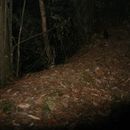Biology
provided by Arkive
These shy, elusive birds live singly or in pairs (4). Unlike most of their pheasant relatives, Temminck's tragopan prefers to nest in trees (4), although spends most of the daytime on the ground scratching for flowers, leaves, grass-stalks, ferns, mosses, berries, seeds and the occasional insect (2) (5).
The mating season starts in March and lasts about a month or so. Courting males attempting to entice females to mate inflate the large, brightly-coloured patch on their throat, erect the two long fleshy horns above their eyes, fan their tail and perform an impressive dancing display (5). New nests are usually built in trees just a few feet off the ground, but the abandoned nests of other species are also often taken over, which the female then lines with leaves, twigs and feathers (2) (4) (5). Three to five eggs are laid per clutch from early May and incubated for 26 to 28 days by the female (2). Raised solely by the hen (2), the chicks develop quickly and are able to fly just days after hatching (4). Nevertheless, the female remains with her chicks for about a month to six weeks, until they are able to feed themselves and are capable of climbing to safety in trees (5).
Conservation
provided by Arkive
Fortunately, this magnificently adorned pheasant is recorded in over 30 protected areas in China and in Mehao Wildlife Sanctuary in northeast India, where it should remain safe for the foreseeable future (2).
Description
provided by Arkive
This colourful bird is considered by many to be the most beautiful pheasant in the world (3). Males are bright orange-crimson, spotted with pearl-grey dots below and black-bordered white dots above. Perhaps even more striking is the vivid pale-blue skin of the face and bib-like wattle that hangs from the throat, typical of tragopan males, bearing a spectacular pattern of darker blue-violet markings down the centre, and conspicuous scarlet markings down each side (3) (4). The crown and neck are mostly black (3), and like other tragopan males, this species has two fleshy, horn-like projections above the eyes, and a very short bill (4). In contrast to the extravagant array of colours boasted by males, females have a dull plumage mottled with black, brown and grey, which helps camouflage them in their forest habitat (4). Both males and females have short tails (3).
Habitat
provided by Arkive
Found in evergreen and mixed forest, often where there is dense rhododendron and bamboo (2), between 3,000 and 12,000 ft above sea level (4).
Range
provided by Arkive
Temminck's tragopan is wide-ranging across the eastern Himalayan mountains, being found in eastern India, China, Bhutan, Myanmar and Vietnam (1) (3). The species migrates vertically up and down the mountain slopes according to the seasons, spending the cold winters at lower altitudes, and moving to higher altitudes as the temperature rises during spring (3).
Status
provided by Arkive
Classified as Least Concern (LC) on the IUCN Red List 2006 (1).
Threats
provided by Arkive
Temminck's tragopan is becoming increasingly threatened as humans and their livestock invade and encroach upon its forests. Over-grazing and understorey cutting is destroying and degrading its habitat (2), while egg-collecting and hunting for its colourful feathers also poses a threat (5). Nevertheless, the species still has a large population in an expansive range (1), and although its numbers are believed to be declining, it is not considered globally threatened (3).
Temminck's tragopan
provided by wikipedia EN
The Temminck's tragopan (Tragopan temminckii) is a medium-sized, approximately 64 cm long, pheasant in the genus Tragopan. The male is a stocky red-and-orange bird with white-spotted plumage, black bill and pink legs. The male's display features include bare blue facial skin, inflatable dark-blue lappet and horns. The females are a white-spotted brown with blue circular eye skin.
Its appearance resembles the satyr tragopan, but unlike the latter species it has a all red upperbody plumage and an orange collar. The diet consists mainly of berries, grass and plants.
The Temminck's tragopan is found across the mountains of far northeast India, central China, far northern Myanmar to northwestern Tonkin.
Widespread and a common species throughout its large habitat range, the Temminck's tragopan is evaluated as Least Concern on the IUCN Red List of Threatened Species.
This bird's common name and Latin binomial commemorate the Dutch naturalist Coenraad Jacob Temminck.[2]
References

- license
- cc-by-sa-3.0
- copyright
- Wikipedia authors and editors
Temminck's tragopan: Brief Summary
provided by wikipedia EN
The Temminck's tragopan (Tragopan temminckii) is a medium-sized, approximately 64 cm long, pheasant in the genus Tragopan. The male is a stocky red-and-orange bird with white-spotted plumage, black bill and pink legs. The male's display features include bare blue facial skin, inflatable dark-blue lappet and horns. The females are a white-spotted brown with blue circular eye skin.
Its appearance resembles the satyr tragopan, but unlike the latter species it has a all red upperbody plumage and an orange collar. The diet consists mainly of berries, grass and plants.
The Temminck's tragopan is found across the mountains of far northeast India, central China, far northern Myanmar to northwestern Tonkin.
Widespread and a common species throughout its large habitat range, the Temminck's tragopan is evaluated as Least Concern on the IUCN Red List of Threatened Species.
This bird's common name and Latin binomial commemorate the Dutch naturalist Coenraad Jacob Temminck.
- license
- cc-by-sa-3.0
- copyright
- Wikipedia authors and editors

